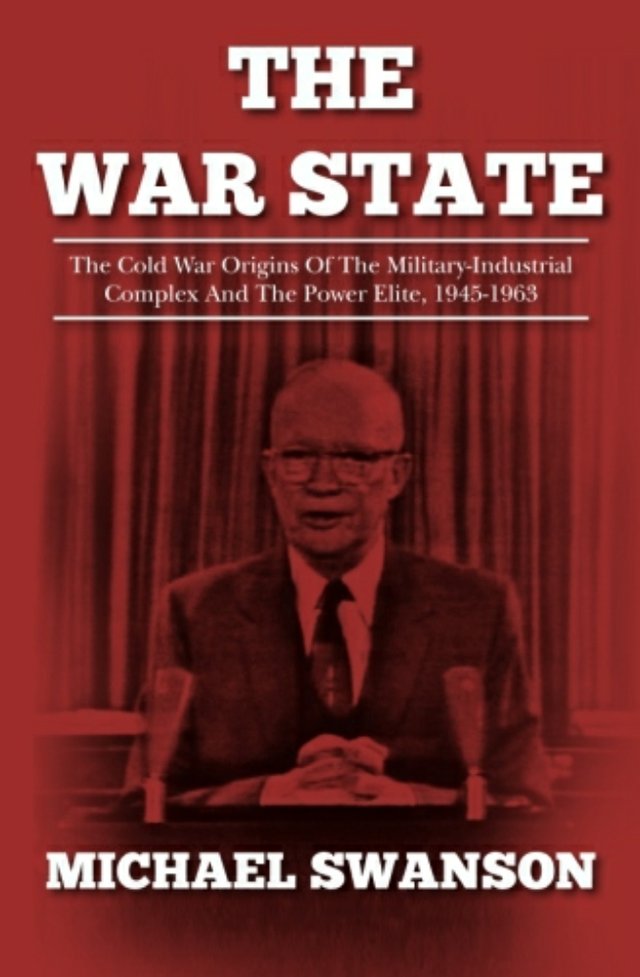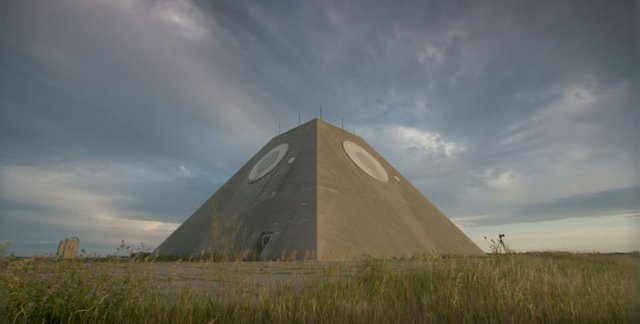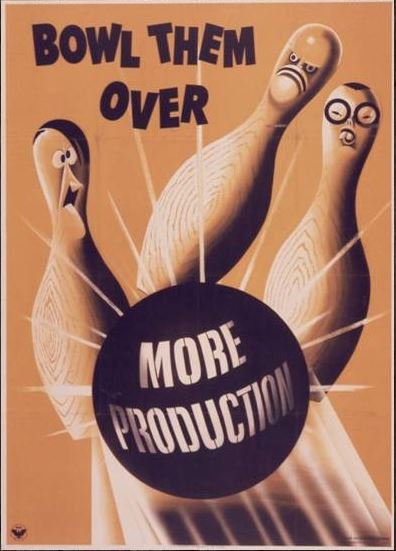A Serialized Book Summary, Analysis and Commentary on The War State, by Michael Swanson – Part Three

Originally published on www.denverlibertarian.com
The following is part three of a three part series reviewing the book The War State, By Michael Swanson.
Part One can be found here. Part Two can be found here. If you are good with reading things out of sequence, then dig in to the article below!
Part Three:
NSC-68, Propaganda and Bureaucracy
Written by and presented to President Harry Truman in 1950 by the Department of State and Department of Defense, NSC-68 was a top secret National Security Council (NSC) policy paper that described the threats and challenges facing the United States in cataclysmic terms that involved the destruction of not only the Republic, but the whole of humanity as well, if certain government and military interventions were not implemented. For many Americans, the existence of the Constitution guarantees a means to reign in overreaching executive actions and maintains the checks and balances that keep wayward government entities from running wild with power. Once NSC-68 was put in place under a veil of secrecy, this unseen mechanism would determine courses of action outside any modicum of authorization or pretense of representation. Far beyond mere planning, it enabled unelected experts to dictate to military leaders and the general population what was best for their security and well being. Edward Bernays foresaw this in his book Propaganda, where he argued that, “the conscious and intelligent manipulation of the organized habits and opinions of the masses is an important element in democratic society. Those who manipulate this unseen mechanism of society constitute an invisible government which is the true ruling power of our country.” (p. 129) Indeed, there is no truer example of this than NSC-68, which was implemented outside any formal review or referendum by the people. In The War State, author Michael Swanson described the process thusly:

New Enemies, Real and Imagined
One might expect that after WWII peacetime would resume and military expenditures would be drastically cut given the defeat of the evil enemy, but alas, a new boogeyman was created to fill the void. The great adversary to come out of WWII targeted by NSC-68 was the Soviet Union, who was portrayed as a grave threat to the U.S. and for democracy writ large. Having suffered tremendous casualties during WWII and with an economy stretched beyond thin, claiming that the Soviet Union was the greatest threat to the U.S. would be a tenuous argument for the public to believe, but a veritable tsunami of propaganda was about to broadside the unsuspecting populace, who were well trained in deference to government omniscience. This deluge of propaganda promulgated a culture of fear, which became the norm for the foreseeable future. The message was clear: the only entity that could protect anyone from the unseen evildoers in a faraway land, was a massive military-security apparatus.
Swanson described it thusly:
“Thanks to exaggerations in news stories and pure propaganda, Americans lived in the 1950s in a state of terror over nuclear war when the Soviet Union didn’t even have the capability to launch a missile that was able to reach the United States until the 1960s. Nor did it have a viable bomber force. In the 1950s, Air Force General Curtis LeMay said he had the ability to order SAC [Strategic Air Command] bombers to attack the Soviet Union and destroy all of its war-making capabilities ‘without losing a man to their defenses.’ Americans were completely safe, but they lived in constant fear.” (p. 394)

For more on the Nekoma facility, see this article. Sometimes truth is stranger than fiction. Mind you, this was one facility in a veritable sea of military construction expenditures for the United States. Of course, massive military expenditures were not unique to the U.S. in this era, for enormous nation states naturally tend to expand and will come up with any excuse to necessitate construction of ever larger military bases in the name of security. To wit, the Soviet Union was no stranger to this desire as can be evidenced by thislong abandoned air base for the 126th Fighter Aviation Regiment, located on the edge of the Gobi Desert in Mongolia, a full 2,700 miles from Moscow. Both the Nekoma facility and the Gobi Desert air base were recently covered on separate episodes of the Science Channel show Mysteries of the Abandoned and the imagery is striking, but any criticism of the War State is eerily left out of the discussion, leaving the only mystery being how the war time propaganda is still in full force, some sixty years after their construction and subsequent abandonment.
Perhaps one of the best takeaways of the book is the realization that such a small percentage of opinion molders were able to convince the bureaucracy and the average citizen that there was an imminent Soviet threat that could only be addressed by a massive military apparatus. Swanson provides some context regarding the standard assumptions with respect to Soviet military capabilities of the era:
“The Soviet Union, however, was not as powerful as the American politicians, reporters, and national security bureaucrats linked to the military-industrial complex claimed it was. NSC-68, written and approved as the guiding national security document for the United States in 1950, argued that if the country did not vastly increase its defense spending, then in just a few years Russia would be on track to produce enough conventional and nuclear weapons that they would be able to completely run over Western Europe and defeat the United States in an atomic attack. During the Eisenhower administration, politicians, such Senator Henry Jackson of Washington, linked to Boeing and other defense contractors, claimed that the Soviet Union had produced so many bombers that a ‘bomber gap’ existed, while the Gaither Report [a committee tasked by President Eisenhower] claimed that by 1960 Khrushchev would have the ability to launch a first-strike missile launch that would cripple the ability of the United States to retaliate. Such claims helped complete the transformation of the United States into a permanent war state by the end of the 1950s, but none of them were even close to reality.” (p. 264)
Continuing on, Swanson clarifies for the reader that:
“Yes, in 1955, the Soviet Union had plenty of nuclear bombs and was more than capable of exploding them in tests, but it had no way to deliver any of them as a weapon against an American city. The American B-52 bomber could fly 7,343 miles when refueled, which was far enough to reach the Soviet Union, but the Russia M-4, called the Bison bomber by NATO, couldn’t reach the United States, because its designers couldn’t figure out an easy way to refuel it in the air. The M-4 could only fly five thousand miles, which was too short for it to reach either coast of the United States from the closest point of the Soviet Union.” (p. 265)

An astonishing example of this was that although the Soviets only had four M-4 bombers, “when the Russians put on a major air show, they took the four bombers and had them fly around in wide circles to give the impression that there were dozens of them. Khrushchev was pleased when American newspapers reported on a supposed ‘bomber gap’ thanks to the Bison bomber. They saw what they wanted to see.” [emphasis added] (p. 265) So much for all that fourth estate, junior high textbook definition of the media keeping a watchful eye on the government. Indeed, the in-depth recounting of the true capabilities of the Soviet military is one of the great takeaways from the book. This was all hidden from the American public and the myth of the necessity of a massive military buildup in order to deal with an embellished threat took hold and continues today. Swanson dismantles this mythology:
“In reality, the Soviet rocket program was pitiful. The R-7 could barely function as a viable weapon. It weighed three hundred tons and operated on liquid oxygen fuel. That made it so that when the rockets were fueled up they were in danger of exploding. American missiles used solid fuel, which enabled them to be launched on about ten minutes’ notice. The Russians, though, couldn’t keep their missiles fueled up all of the time. That meant it took them hours to prepare them for launch, making them very vulnerable to attack.” (p. 266)
Of course, the standard objection is, but how were we to know! It turns out, it didn’t matter, the agenda was already set, facts be damned! This is an all too familiar occurrence within the standard operating procedure for government. Look over there! A threat! We must act immediately! For example, take the infamous declaration of President George W. Bush when he said that, “we have to abandon free market principles to save the free market system” or, “we must pass the bill to see what is in the bill,” as Speaker of the House Nancy Pelosi declared in 2010. Perhaps more to the point would be the Afghanistan Papers, where U.S. officials and their media lapdogs willingly misled the American people regarding progress, or lack thereof, in Afghanistan. In the end, when the reality of the situation is brought to light, those “looking out for the People” newsmen, after years of willingly misleading the public, will downplay the situation under the well worn guise of, they were just following orders, doing their best, how could they have known, etc. It’s just another random side note in a never ending war that the general public will have easily forgotten when the next faux crisis emerges. Just remember to stand and pledge allegiance, otherwise everyone will get all fired up. Invade and occupy a county on false pretenses for eighteen years and kill thousands upon thousands? Meh. The War State prefers that you are at odds with your fellow man, since it inherently requires a distracted populace.
Although it was kept secret from the general population, the CIA and the government knew about the pitiful state of Soviet military capabilities, as Swanson recounts to the reader that “...after twelve failed launches, the CIA put into space its first spy satellite code-named Corona. It passed over Russia and found that their few intercontinental missiles were all at one launch facility, which made them vulnerable to a surprise attack. They also now had 200 bombers with questionable ability to reach the United States and seventy-eight missiles on about a dozen submarines that spent almost all of their time in port. The United States had more than an overwhelming nuclear strike advantage over the Soviet Union. Yes, there was a missile gap, but it was in favor of the United States.” (p. 296) [emphasis added]. The threat was fabricated; a blatant and outright falsification of data and if it could be done in this scenario, it could be easily done elsewhere. The stage was set for the CIA to run wild.
CIA and Less than Powerful Pieces of Paper
The implausibility of being able to centrally plan an entire economy made up of 327 million individual actors is akin to the implausibility of trying to reign in the War State. The mythological telling of an infallible system of checks and balances is laughable and any alleged Constitutional limitations or constraints are most easily dispensed with. Rank and file bureaucrats, military leaders and most certainly the Presidents are given plausible deniability and benefit of the doubt far beyond what any average civilian would receive during even the most routine investigation of the most basic crime. When a black ops adventure goes awry, the President can and will deny giving authorization for that particular overreach and the military can and will claim that they thought the original authorization gave them the authority to proceed. It’s a win-win for both entities, for how can you question the heat of the moment decisions that a soldier made? He is just doing the best he can! This has been and continues to be the status quo when it comes to covert operations. Swanson explains it it in this passage:
“In theory, the CIA does not engage in any covert activity without the approval of the president and the oversight of Congress. In reality, there is so little oversight over agency activities that often the leaders of the agency itself do not know everything that is going on. The president often approves one covert operation only to have it spawn even more operations that no one at the top is responsible for. How can this be? As Clark Clifford, who served as an aide to Harry Truman and as secretary of defense for Lyndon Johnson explained, ‘on a number of occasions a plan for covert action has been presented to the NSC and authority requested for the CIA to proceed from point A to point B. The authority will be given and the action will be launched. When point B is reached, the persons in charge feel that it is necessary to go to point C and they assume that the original authorization gives them such a right. From point C, they go to D, and possibly E, and even further.’ This led to some bizarre results, and, when investigation is started, the excuse blandly presented was that the authority was obtained from the NSC before the project was launched.” (p. 100)
Lest one think that that is all in the past and that the U.S. has learned from its mistakes over the years, just this May, as recounted on this Antiwar.com article by Thomas Knapp, “a group of around 60 mercenaries attempted an amphibious landing at Macuto, on Venezuela’s Caribbean coast. They were quickly defeated and 13 of them – including two Americans, Airan Berry and Luke Denman – [were] captured.” Predictably, President Donald Trump has denied any association with, knowledge of, or involvement in the affair on the part of the U.S. government. Indeed, the more things change, the more they stay the same.
The Constitution is unable to prevent or guard against these situations, yet isn’t that what everyone has been trained to say: the soldiers are over there defending our freedoms, our way of life, our Constitution? The CIA operates in an extra-constitutional manner everyday. Some may say that it’s just the fog of war and we should just get over it, but Swanson has an answer for that too, because it isn’t just CIA operatives taking the operation to an unauthorized level, it’s a systematic process of looting the American public:
“The agency funneled ten million dollars out of the Marshall Plan and laundered it through various bank accounts of American Italians, who in turn ‘donated’ the funds to CIA front organizations and the Christian Democratic political party in Italy as charitable tax deductions.” (p. 117) It seems a little complicated, but this procedure had several justifications, “...it enabled the individuals who agreed to assist the CIA to do so without violating United States tax laws and it gave the CIA an internal audit procedure to provide a check on the flow and amount of money.” (p. 117) This is just one declassified example, there are no doubt countless other operations buried in classified archives. If it was all on the up and up, one would expect for it to have happened out in the open, under the watchful eye of Congress, but it remained a secret until well after the Cold War ended. Untraceable cash, who wouldn’t want that?
Author Michael Swanson isn’t the only one to observe this, as Tim Weiner stated in his book Legacy of Ashes: the History of the CIA: "It was a global money-laundering scheme that stayed secret until well after the cold war ended. Where the plan flourished in Europe and in Asia, so would American spies. 'We'd look the other way and give them a little help,' said Colonel R. Allen Griffin, who ran the Marshall Plan's Far East division...Secret funds were the heart of secret operations. The CIA now had an unfailing source of untraceable cash." (p. 32)
Now let’s take a step back and think of George Floyd, murdered in the street for trying to pass a counterfeit note, or Eric Gardner, murdered on the sidewalk for selling loose cigarettes. When the average citizen is purported to have committed a crime, the police descend, swarm and pounce. There is no law so trivial that, if broken, one could die at the hands of the police, but when the government commits a similar crime on an exponentially greater scale? It’s no big deal; it’s business as usual.
Swanson recounts a myriad of CIA black operations the world over and specifically reminds us of the countless operations in South America, an all but forgotten era for a population overwhelmed with, and raised on, continued and never ending wars in the Middle East. Just like the CIA adventures in South America, the current Middle East adventures will be but a mere blip on the sordid historical map of U.S. interventions. There is no sphere of influence in which the War State will not participate and regardless of the outcomes of continued misadventures the funding is continually expanded regardless of the rhetoric of the parity in power.
The Permanent Government
The Permanent Government might seem to be a misnomer to the lay reader. Of course, one might proclaim, we need a permanent government! We should be permanently governed, for without government there would be chaos! This sentiment is odd indeed, given the daily news cycle confirming that we are surrounded by chaos. I can hear the common argument that without government, problem ‘A’ would exist, so easily forgetting that that problem already exists in the current government controlled paradigm.
One can see the Permanent Continuous Government in action with President Trump’s decision to pull troops out of Syria, do you remember that? It wasn’t that long ago, but critics across the political spectrum were quick to come out of the woodwork to lambast the President on this decision. It is when you are getting attacked from all sides that you know you are getting to the heart of the matter. We are only a few months removed from this situation and many have already forgotten the hysteria surrounding the decision after being quickly guided to the coronavirus hysteria and non-stop coverage of rioting in the wake of the murder of George Flyod by the knee of a Minneaplis police officer. The United States is still killing people in the Middle East, in Africa and countless other countries the world over; the war machine rolls on even in the midst of a global pandemic and racial unrest.
In conclusion, I’ll leave you with a stunning admission from an unlikely source, a person whose job it was to advance and enable the War State and the State writ large in the name of American Exceptionalism, court historian, Arthur Schlesigner, Jr:
“The permanent government soon developed its own cozy alliances with committees of Congress, its own ties to the press, its own national constituencies. It began to exude the feeling that Presidents come and go but it went on forever. The permanent government was, as such politically neutral; its essential commitment was to doing things as they had been done before...” inevitably, this surrendered, “presidential government to the permanent government.“ [emphasis added] (p. 245) Onward to the next war. Given the current circumstances surrounding police power and government regulatory overreach in the Covid Era in the United States, perhaps a Part Four needs to be written: The War State Comes Home.
This concludes this three part series covering The War State, by Michael Swanson
Part One | Part Two | Part Three
Buy the book here.